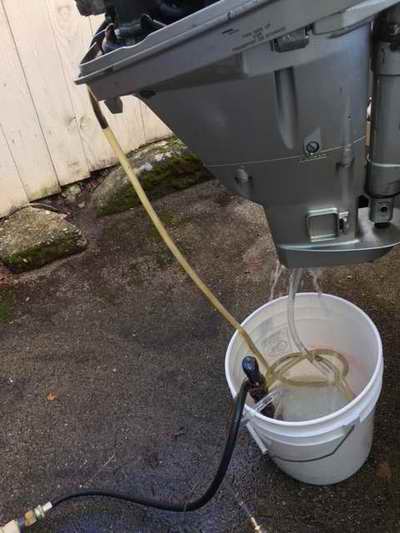|
Seawater is very hard, nearly saturated with calcium and loaded with salt. All that salt needs is something to react with: (uric acid in the marine head) or localized heating (engine), to create a concrete like incrustation in a water passage. Sometimes mechanical removal is possible. A favourite cruiser technique is to beat the sanitation hose on concrete to remove internal scale build-up. But most plumbing systems and engines are inaccessible without considerable disassembly.
A less labour intensive alternative is to dissolve the crystals with an acid descaling chemical that will hopefully dissolve the calcium salts selectively, leaving the expensive metal bits undamaged. Flushing a cup of vinegar through the head each week is a popular scale prevention treatment. Allow it to soak for ~30 minutes before flushing, in hopes that the scale will dissolve, preventing a build-up.
My project began as a pre-season look at the evils that await all outboards that are operated in salt water. The idea was to peek at the water pump, change the sacrificial anode inside the engine and examine the salt build-up that I thought was blocking the water stream leaving the outboard. This happened to be on a 15HP Honda I use on my 14' Lund skiff. Most of this will apply to the 5-10HP outboards that the SJ23 fleet uses.
|
STEP |
MAINTENANCE |
ACTION |
|
|
I try to keep a stock of gaskets for the engine innards, plus other parts like shear pins, fuel line, etc. to avoid waiting on parts delivery. This Honda 15HP has a sacrificial anode located deep behind the intake manifold. It is buried behind an expensive gasket. I was aware of poor water flow through the engine and out the telltale stream, so I expected salt deposits inside the block.
|
|
1 |
WATER PUMP IMPELLER. |
The water pump inspection and possible replacement was the first job. To do that the lower unit must be removed.
- Replace the impeller if the vanes are hard, cracked or missing. If vanes are missing you should remove them from inside the block.
|
|
2 |
FLUSH THE COOLING CHANNELS OF SALT CRYSTALS.
With the lower unit removed, there is easy access to the water supply tube, which is a convenient entry point to flush the whole engine for salt build-up.
NOTES
- One nice feature of flushing this way is that the flush water does not mix with the exhaust by products as most of it flows down the central outboard case. It also can be done indoors with no fumes.
- And since we should all be changing water pump impellers regularly, this seems like a no-brainer.
- Any water pump will work, as long as it can pump more than 3 feet of head.
- The rate of salt dissolution will be determined by the concentration gradient between total salt and the solubility potential of the vinegar or whatever flush solution is used.
|
I connected a recirculation pump to the water pickup tube and used a bucket beneath the motor to catch the outflow.
For a flush solution, I used straight vinegar. You could use "Salt Away or RidLyme", but I elected for simple chemistry.
A Coleman stove does a nice job of heating the flush solution to ~1200 F (500 C) which is perfect to keep the physics working to effectively dissolve the crystallized salt. After an hour or so of flushing, I removed the intake manifold, and while some salt deposits remained, it was obvious the flushing was working as the remnants of salt crystals were converted to slush. Had I flushed longer, these deposits would also be gone. I will test the specific gravity of the flush solution and compare it to the straight vinegar to get an idea of how much crystalline salt went into solution. That's winemaking skills put to good use. 
|
|
3 |
ANODE |
If the anode is internal to the outboard it is likely prudent to replace it while the engine is apart. Verify that the mounting screws are tight, corrosion free, and the anode is not pitted with holes. An anode that has holes or cracks MUST be replaced.
|
|
I always flush an outboard with fresh water after use in salt water. Pure fresh water should remove the salt, but I can clearly see that the quick dip in fresh water after my typical use was not sufficient to prevent salt build-up. I think an annual trip to the "outboard spa" might be a really good investment. I've learned a ton of good stuff from various bloggers with boats like ours. Being self-sufficient really pays off when you're in places like the West Coast of Vancouver Island. Glen Moore
|
See Tech Tip D08, Replace Impeller if the tell tale stream appears weak.
|
